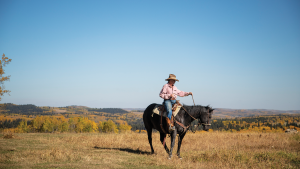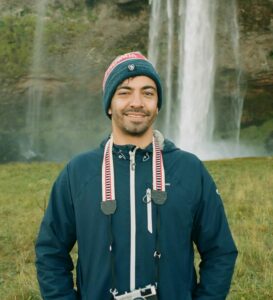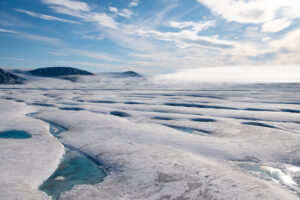Travel
Secret season in Jasper: 3 days of ice walking, ice skating and other winter adventures
Avoid the crowds and discover frozen canyons, scenic lakes and hearty cuisine in this epic Rocky Mountain town
-
Oct 19, 2023
-
2,010 words
-
9 minutes
The first view of the Rocky Mountains as you drive the road from Calgary is almost overwhelming.
The late-winter ice has fortified these formidable peaks to the point that I should surely feel daunted. Yet, the effect is somehow opposite; I find myself drawn to them. I imagine being propelled along marvelous icefields, dragged willingly past awesome glaciers and pitched cheerfully down frozen canyons. I’m filled with the urge to ascend further into this jagged range of glaciated limestone and shale and breathe in the exhilaratingly icy air.
Luckily, there’s a town where I can do all of that and more. Perched 1,000 metres above sea level, deep in the beating heart of the Rockies, is Jasper, Alta. And while many flock to these mountains’ crests and spires in January and February for snow-filled fun, March is Jasper’s secret season, offering a calmer yet equally invigorating alpine experience.
Day 1: Prairies to peaks — the route from Calgary
When it comes to Jasper, it’s not just about the destination itself. It’s about how you get there. Whether your starting point is Calgary, Edmonton or Vancouver, there’s a metric ton of scenery and activities to dive into along the way.
I touch down on a crisp winter morning knowing the journey ahead from Calgary International Airport to the Rockies is going to be straightforward, comfortable and filled with breathtaking views. Car rental agencies are plentiful, but if, like me, you want a more laid-back journey, the Brewster Express Airport Shuttle is the way to go. With eyes free to wander the passing landscape, I watch enthralled as the Trans-Canada Highway delivers me from airport arrivals to rural Prairie landscape to the suddenly jagged edges of the Rockies.
Calgary to Jasper in one shot can be a tough task, especially after a long flight. Instead, I alight at the lively tourist town of Banff, itself home to some of the most iconic lakes, mountains and views the Rockies have to offer. When I step off the bus, it’s March in the mountains, so it’s cold, and I’m more than happy to envelop myself in the welcoming arms of the Mount Royal Hotel, located at the centre of Banff Avenue and boasting one of the best restaurants in town, Brazen. Aromatic ginger beef, mushrooms caps stuffed with miso and wasabi, and truffle parmesan potatoes drizzled in honey butter warm me up in the most delectable way, and a crème brûlée disguised as an ashtray, white chocolate cigarettes and all, sends me to bed with smile.
For more Banff tips, read here.
Where to stay: Mount Royal Hotel
What to eat: Ginger beef, miso-wasabi stuffed mushrooms caps, truffle parmesan potatoes and crème brûlée at Brazen
Alternative routes
From Edmonton
By road: Several operators offer shuttle services, including SunDog Tours. By car, take the Yellowhead Highway, stopping to explore the small towns along the way.
By rail: Leaving from Edmonton offers a third option: the train! VIA Rail runs a leisurely six and half hour journey direct to Jasper that meanders through the mountain terrain. Surely the most relaxing way to travel.
From Vancouver
By road: The quickest route from Vancouver to Jasper takes about nine hours by car. Take the Trans-Canada Highway to Hope, B.C., then take Highway 5 through Kamloops before turning onto Highway 16 near Valemount. Longer, more scenic alternatives allow you to see Whistler, Lake Louise and the Icefields Parkway.
By rail: From Vancouver, you have two options by train. The luxurious Rocky Mountaineer offers stunning sights and great hospitality, and can be made in two days, with a one-night stop in Kamloops. For a more affordable option, VIA Rail runs two trains between Vancouver and Jasper per week. The VIA route takes about 20 hours, so split this journey into two as well, if possible.
Day 2: Guided by ice — from Banff to Jasper
The next morning, I grab breakfast and watch the rising sun light up the mountain peaks surrounding Banff before setting off for Jasper. As impressive as Banff is, I’m excited to leave the crowds of tourists behind and seek adventure in the more secluded parts of these mountains. I grab a bagged lunch to go from my breakfast spot, the open-all-day Farm & Fire, and switch to a SunDog Tour bus.
The route from Banff to Jasper is a must because it utilizes one of the most unique roads in Canada: the Icefields Parkway. When you travel this road, you’re quite literally driving along the backbone of North America, as this 227-km mountain road is built almost parallel with the Continental Divide of the Americas. Starting just off Lake Louise, the road winds through icy mountain peaks and valleys lined with snow-topped conifers. The winter freeze means views are outstanding, and as we ascend ever higher I catch glimpses of off-piste skiers cutting deep trails in the snow.
Our driver speaks passionately about the wonders of these mountains and the contentment he finds knowing this well-protected landscape will remain mostly unchanged for generations to come. His commentary is punctuated by stops at some of the magnificent viewpoints along the way, such as Bow Lake — its emerald waters now covered in thick layers of ice and snow — and, most memorably, the Athabasca Glacier, one of the six principal “toes” of the Columbia Icefield. The once mighty glacier is now much reduced by our warming climate, making this glimpse of the waning river of ancient ice even more profound.
Overlooking the glacier is Snow Dome, which, our driver informs me, is one of the most mountain peaks I’ll ever see. Topped by four glaciers, it’s a hydrological apex — a single point where three great watersheds meet. The mountain straddles both the Continental Divide of the Americas and the Arctic Divide, meaning water from its peak actually feeds all three of Canada’s oceans. If a drop of water falls on Snow Dome’s peak’s western face, it will eventually find its way to the Pacific Ocean via the Columbia River. On its northern face, the raindrop will find its way to the Arctic Ocean via the Athabasca River, and on its eastern face, towards the Atlantic, the North Saskatchewan River and Hudson Bay. It’s the only mountain in North America, perhaps the world, that feeds three oceans.
We arrive in Jasper about three hours later, where we’re met by a large herd of elk. I can’t think of a better reception.
Jasper — heart of the Rockies
Jasper is Banff’s quieter cousin, even more so in March. Similarly surrounded by imposing mountains, the touristic buzz of Banff is left behind. In its place is a calmer, earthier feel. Forget shopping and boutique hotels, Jasper is a cozy fire in a rustic lodge with window views of elk and bighorn sheep roaming pristine mountain landscapes.
Ice is on my mind. I’ve looked down on frozen lakes and marvelled at icefields from afar. Now it’s time to get up close.
About a 10-minute drive outside of Jasper is Pyramid Lake. Famed in the summer months for the small island connected to the mainland by a rather photogenic bridge, winter turns this pristine mountain lake into an idyllic skating rink.
Pyramid Lake Lodge, which sits on the shore of the lake, offers a whole suite of winter activities, including skate rental. As I fit my skates next to the large skating loop that’s been cleared on snow-covered lake, I spot a lone figure carving intricate patterns into the ice. Framed by the awe-inspiring alpine backdrop and silhouetted by the low winter sun, it couldn’t have been a more Canadian moment. Except, perhaps, if the figure skater was a moose.
I spend the next couple of hours brushing up rusty skating skills, gliding with increasing confidence. The scenery and crisp mountain air make it the best skating experience of my life so far.
By the time I check into the Forest Park Hotel, my bed for the next two nights, I’m whole-body tired and ready to relax. The hotel is the first hotel to be built in Jasper National Park in over 40 years, adding a contemporary touch to the rustic charm of the original building it expanded from. Check out the Hearthstone Lounge for more refined rocky mountain cuisine — which, apparently, is a lot more than prairie oysters.
Where to stay: Forest Park Hotel
What to eat: Stone-baked pizzas, short-rib wellington with smoked bacon ale gravy, and a house chai tea spiked with Bacardi spiced rum at the Hearthstone Lounge
Day 3: Ice walking Maligne Canyon
I wolf down breakfast, impatient to get to today’s activity: ice walking Maligne Canyon.
Located just over 10 minutes drive from Jasper, Maligne is the deepest canyon in the Rocky Mountains. Six bridges criss-cross above, allowing hikers to appreciate the up to 50-metre-deep slot canyon from all angles.
Carved out of malleable limestone by the Maligne River, which flows out of Medicine River about 15 kilometres upstream, the canyon is in a constant state of erosion as water both above ground and below churns and swirls against the rock walls.
In winter, something even more special happens. The river running along the canyon floor freezes into a rolling path of thick ice, and the waterfalls that flow down the canyon’s walls turn to giant frozen curtains, gothic and resplendent. The ravine’s beauty is compounded by the dazzling ice caves that form under the frozen falls, creating a cathedral of ice. In March, expect to have the canyon almost to yourselves.
A guided ice walk is the best way to experience Maligne Canyon’s ethereal beauty, with a 2.5-hour ice walk plus lunch at the nearby Maligne Canyon Wilderness kitchen going for $79.99 per adult. Crampons and helmets are included.
Over the next two and a half hours, I crunch, slither and slide my way into the depths of the canyon. Sculpted walls of limestone and ice tower over me and dagger-like icicles guard the entrance to caves of ice. The atmosphere is ethereal.
That evening, I sit before a roaring fireplace in the comforting surroundings of another great Jasper restaurant, Terra. Rugged yet refined dishes like Alberta steak frites and home-made game sausage are devoured with the most restraint my tired body can muster.
An “apple-basca” old fashioned in hand, I steel myself for the journey home tomorrow. Like the mighty Athabasca River that my drink is named for, I must soon leave the majestic slice of nature called Jasper National Park and head east. Once the Rocky Mountains — and Jasper, in particular — have you, like gravity, they take ownership of you. These mountains are a place that pulls. You return to your home in a flat city and, from time to time, find yourself glancing up towards the skyline expecting to find great towering peaks with jagged, ice-worn edges. And like the shadow of an image burned into an old television set, you do faintly see them above the condos and brickwork. Ghostly, but very much there.
Where to stay: Forest Park Hotel
What to eat: Beef, silvan star gouda, kale, caramelized onions and horseradish aioli sandwich on schiacciata herb bread with a hot chocolate at the Maligne Canyon Wilderness Kitchen; Alberta 10 oz. striploin steak with rosemary fries and red wine jus with an apple-basca old fashioned at Terra























